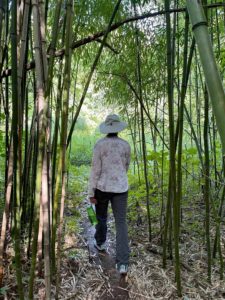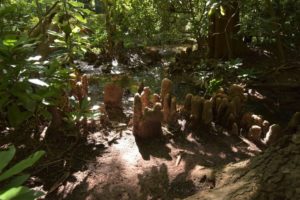Hello Fellow Readers, What a delight to wander through Willowwood Arboretum, invited by dear friends Ruth and Jim of Hope, NJ. I had never heard about the public garden, free to visit; that’s part of the Morris County Park system. Tucked away in Far Hills, NJ, the journey through the seldom traveled roads to the lovely estate is part of the adventure.
As you enter Willowwood, an open expanse of meadows of wispy grasses with pops of yellow, orange, and pinks greet you. It’s called Hacklebarney Field with willows, oaks, flowering trees, and wildflowers. The meandering paths throughout invite me to return someday for a stroll.
History of Willowwood Arboretum
Willowwood Arboretum was the country residence of brothers Henry and Robert Tubbs, who purchased the property in 1908. Both were garden enthusiasts who went far and wide to gather plants. They became friends with their neighbor Martha Brookes Hutcheson, one of the first female landscape architects in the United States. She and her husband William purchased the property in 1912 and named it Merchiston Farm. Now known as Bamboo Brook; also part of the Morris County Park system.
While they were developing the gardens along with Dr. Benjamin Blackburn, Henry’s adopted son, they did so with the ambition to become an arboretum. There are many gardens to enjoy, including a Cottage Garden and a Lilac Collection featured in a spring tour, to name a few. Beyond the main house is Cypress Lawn with Baldcypress (Taxodium distichum), providing a shady canopy above magnificent specimens of Japanese Maple that will burst into a blaze of color come fall.
The Mystery of Cypress Knees.
Then came the most remarkable and amusing part of the journey. The Cypress Pool Garden is filled with cypress knees that look like tiny gnomes gathering around swampy pools of water. It’s a mystery the purpose they serve. Some say they help roots to absorb oxygen in the waterlogged soil. Others say it’s a way of stabilizing the trees in swampy conditions.
Willowwood is considered New Jersey’s most extensive and longest operating arboretum, with unusual collections of treasured trees and other plants. Many of the trees are Champion Trees. It’s an interesting concept they label them as such. The word champion means one that out-competes another. Or somebody that advocates and supports a cause or mission. But trees need each other.
Trees Need Each Other
Trees connect in a forest and need each other to thrive, as is so beautifully written by Peter Wohlleben, author of The Hidden Life of Trees: What They Feel, How They Communicate―Discoveries from a Secret World.
Peter Wohlleben writes, “But why are trees social beings? Why do they share food with their species and sometimes nourish their competitors? The reasons are the same as for human communities: there are advantages to working together.”
That is why there are more old trees in forests than living on their own as stand-alone trees.
Willowwood Arboretum – home to 13 Champion Trees
The criteria to become a champion tree are height, trunk circumference, and crown spread (the width of the canopy). There are thirteen NJ State Champion Trees at Willowwood, including a stunning Katsura tree (Cercidiphyllum japonicum), one of my favorites. Native to Japan the specimen shade tree’s heart-shaped leaves emerge reddish-purple and shift to blue-green, then turn yellow or apricot come fall.
Another is an enormous Dawn Redwood (Metasequoia glyptostroboides), also recently named a National Champion. Dawn Redwood are ancient trees that lived during the dinosaur age and remain a favored landscape tree today. With feathery bright green leaves that turn orange or reddish-brown in the fall. Planted in 1950, the National Champion was a seedling from Princeton University. It now stands 112 feet with a sixty-foot wide canopy. And the circumference of the trunk is a whopping 212 inches.
Given that Willowwood Arboretum has so many of the state’s champion trees, perhaps the whole forest is the champion. Better yet, let’s not label them at all, and let’s embrace the miracle and grandness of all trees.
Garden Dilemmas? AskMaryStone@gmail.com (and on your favorite Podcast App).
This story is featured in Episode 34 of the Garden Dilemmas Podcast. (Click the green arrow below or on your favorite Podcast App.)
Link to more about Willowwood Arboretum
Link to Morton Arboretum’s summary of Katsura Trees and Dawn Redwood
Peter Wohlleben’s book The Hidden Life of Trees is also featured in Talking to Trees on Arbor Day.








